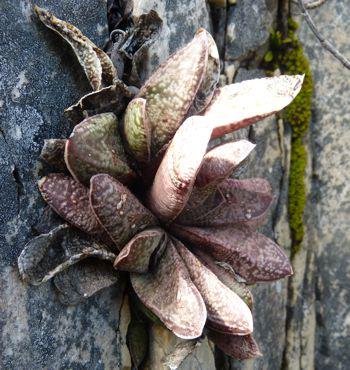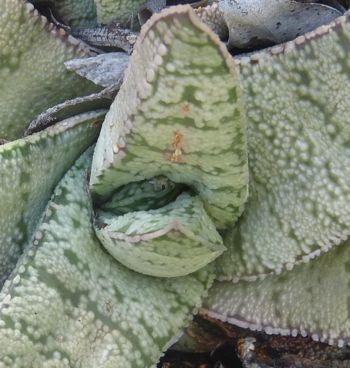Gasteria barbae
Gasteria barbae Van Jaarsv.
Family: Asphodelaceae
Common names: Hakerville gasteria
Introduction
Gasteria barbae is an exciting, new discovery confined to the coastal cliffs near Hakerville in the Knysna District. It has small rosettes of leaves covered in dense, white tubercles in zebra-like, transverse bands. The leaves are brittle and very prolific, forming plantlets.

Description
Description
Plants stemless, ascending 80–120 mm tall, up to 80–240 mm in diameter, solitary or proliferating from the base and cluster-forming (3–5 heads). The roots are succulent, 3–4 mm in diameter.
The leaves, 8–12 per rosette, are elongated and spear-shaped (linear-lanceolate) to triangular, and grouped into a central rosette, up to 120–170 mm long, 22–38 mm broad at the base, often sickle-shaped (falcate) and ascending spreading, sometimes becoming flat; upper surface flat to becoming channeled, plane towards the tip, dark green to greyish green (becoming reddish during the dry season), densely white-warty in faint transverse bands; lower surface convex with a distinct eccentric keel, densely warty (tuberculate), the warts (tubercles) arranged in faint transverse bands. The leaf margin has small white teeth (denticulate). The teeth (marginal tubercles) are 1.0–1.5 mm high. The leaf tip is acute or sometimes with a drawn-out, tapering end, ending in a short, sharp point (mucro). The juvenile leaves stand in two opposite rows (distichous), strap-shaped flat to ascending and the leaf surface similar to the adult plants.

The inflorescence consists of a simple raceme about 270 mm long, bearing 18–26 orange-red to pinkish flowers (up to 2–6 flowers open at the same time). When opening, the flowers all point towards the plant (secondly arranged). The flower (perianth) is cylindrical, slightly curved and drawn out (oblong), 35–38 mm long and 5–6 mm broad, slightly inflated at the base, the floral parts (segments) fused for their greater length, except at their ends. The stamens are 28 mm long; anthers about 2 × 1 mm long, included or shortly exerted. The ovary oblong, 7 × 2.5 mm, green; style 25 mm long, stigma included or shortly exserted, curved upwards, minute.

The fruiting capsule is 18–30 mm long, and the black seed 3.5–4.0 ×1.5–2.0 mm. Flowering time: November (late spring).
Conservation Status
Status
Although the plant has a restricted distribution confined to coastal cliffs, due to its recent discovery, it has not been listed in the Red List of South African plants.
Distribution and habitat
Distribution description
Gasteria barbae is confined to coastal cliffs between Robberg and Knysna, a rugged area covered mainly in Southern Afrotemperate Forest, as well as South Outeniqua Sandstone Fynbos (Mucina 2006). Plants are locally abundant, confined to mineral-poor and acidic, sandstone cliffs of the Table Mountain Group (Cape Supergroup), growing in rock crevices in partial shade to full sun (altitude of about 50–150 m).
The climate is mild (without frost), representing one of the wettest in southern Africa, with rainfall throughout the year and ranging from 800 to 1 200 mm per annum. The average maximum temperature is about 20–21°C and the average minimum about 12°C.

Associated species common to it the habitat includes, Aloe arborescens, Litanthus pusillus (Drimia uniflora), Crassula perforata, C. nudicaulis, C. rubricaulis and C. lanceolata, Curio crassulifolius (Senecio crassulaefolius) and Bulbine latifolia. Other non-succulent associated plants include, Erica speciosa and Polygala myrtifolia and species of Phylica.
Its closest relative, the large Gasteria acinacifolia, with smooth adult leaves and a spreading floral panicles, grows to the east and west of our new species, and mostly associated with dune vegetation. Gasteria polita, another fynbos species, grows away from the sea, on steep hilly terrain to the north. It has smooth leaves and shorter flowers. Gasteria barbae grows in humus-rich crevices and ledges.
Derivation of name and historical aspects
History
Gasteria barbae was discovered by Mr Johan Baard from SANPARKS (Knysna) who brought this new species to my notice. It was also named for him (Baard = bearded, hence the specific epithet ‘barbae’). Johan has contributed significantly to the knowledge of the Harkerville, Knysna flora. It was named by the author in Cactus World, the journal of the British Cactus & Succulent Society, in 2014.
Gasteria belong to the family: Asphodelaceae subfamily Alooideae. Gasteria barbae belongs to section longiflorae Haw., series longifoliae Haw. This section includes five species, G. acinacifolia (J.Jacq.) Haw., G. batesiana G.D.Rowley, G. croucheri (Hook.f.) Baker and G. tukhelensis Van Jaarsv. (Van Jaarsveld 1994). All these species have large flowers (33–45 mm long).
Ecology
Ecology
The large, tubular orange-red to pinkish flowers are pendent and pollinated by local sunbirds. After fertilization the capsules mature and becomes erect, opening from the end . Strong winds release seed from the capsules, and so are dispersed. The leaves of Gasteria barbae are very brittle and when they become detached, they will rapidly callus ( form heeling tissue) and root, forming new plantlets. This vegetative propagation is often associated with cliff-dwelling, succulent plants (Van Jaarsveld 2011).
Uses
Use
Apart from its horticultural potential, it is not known to be used in other cultural practices.
Growing Gasteria barbae
Grow
Gasteria barbae is an attractive plant with horticultural appeal. It is characterized by its decorative white warty (tuberculate) in transverse zebra-like bands, elongate-triangular leaves becoming reddish during the dry season. This species is easily propagated by leaf cuttings or seed. If grown in shady conditions, the leaves tend to be longer and greener, as opposed to plants growing in full sun, bearing much shorter, compact leaves.
Gasteria barbae grows well in cultivation (on window sills) and does best as a containerized plant or grown in miniature rock gardens. In cold climates where frost is a problem, it should rather be grown in a greenhouse under controlled conditions. It is a prolific grower and its stoloniferous nature and leaf proliferation, soon ensures dense clusters. Gasteria barbae is a slow grower, but this can be hastened with an organic fertilizer. Gasteria barbae is best cultivated in fynbos gardens (Van Jaarsveld 2010), or similarly dry Mediterranean-type gardens in other parts of the world, where frost is not too severe. Plants prefer partial shade, and in hot climates, should therefore be protected from full sun. Flowering size can be reached in about three years. It is best to pollinate the flowers by hand, ensuring the true offspring. This can be accomplished with a sharpened match stick and by transferring the pollen from a genetically different plant, to the stigma, ensuring that the species breeds true.
Propagation
Gasteria barbae is easily propagated from seed, stolons, or leaf cuttings. It is best to apply a fungal inoculant or fungicide when grown from seed. Sow seed preferably during the warmer months autumn, spring or summer in a shady position in a sandy slightly acidic soil and keep moist. Cover with a thin layer of sand and keep moist. Germination is usually within three weeks. Seedlings grow slowly and are best planted out when large enough to handle.
Propagation from leaf cuttings can be undertaken throughout the year. Allow the leaf cutting to form a heel by placing it on a dry window sill for a week or more. Cuttings are best rooted in a small container in a well-drained medium. Once rooted, plantlets will appear at the base of the leaf and these can be detached once they are strong and large enough to handle. Best to feed plants with an organic feeding (compost or any other liquid fertilizer). Gasteria barbae can be watered at any time of the year, however, watering should be reduced during winter.
References
- Mucina, L. & Rutherford, M.C. 2006. The vegetation of South Africa, Lesotho and Swaziland. Strelitzia 19. South African National Biodiversity Institute, Pretoria.
- Van Jaarsveld, E.J. 1994. Gasterias of South Africa. Fernwood Press, Vlaeberg.
- Van Jaarsveld, E.J. 2011. Cremnophilous succulents of southern Africa: diversity, structure and adaptations. Unpublished Ph.D.Thesis, University of Pretoria.
- Van Jaarsveld, E.J. 2014. Gasteria barbae, a new cliff-dwelling species from the Western Cape, South Africa. Cactus World, Vol 32, 4: 257–260.
Credits
Ernst van Jaarsveld
Kirstenbosch NBG
March 2015
Plant Attributes:
Plant Type: Succulent
SA Distribution: Western Cape
Soil type: Sandy
Flowering season: Spring
PH: Acid
Flower colour: Red, Pink, Orange
Aspect: Full Sun, Shade, Morning Sun (Semi Shade), Afternoon Sun (Semi Shade)
Gardening skill: Easy
Special Features:
Horticultural zones








Rate this article
Article well written and informative
Rate this plant
Is this an interesting plant?
Login to add your Comment
Back to topNot registered yet? Click here to register.